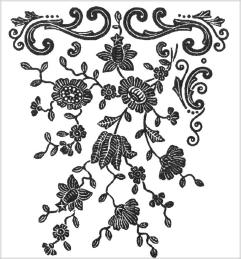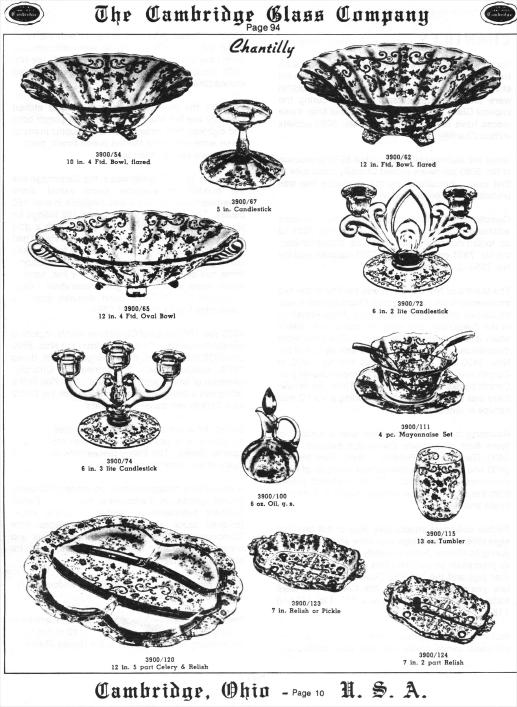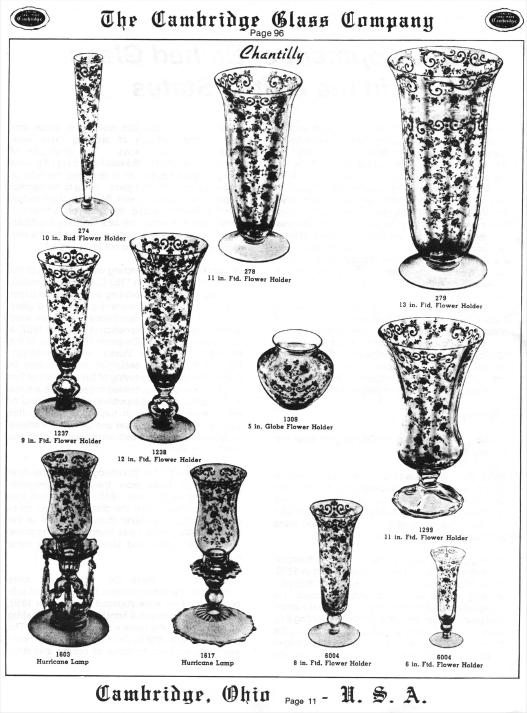CHANTILLY: Delicacy and Refinement
By Mark A.
Nye
Issue No. 272 - December 1995
This is the third in a series of articles that will revisit some of the topics covered in previous columns, some of which were published a number of years ago. Versions of the article on Chantilly have previously appeared in the Crystal Ball, The DAZE, and the now defunct Glass Review.
A new Cambridge catalog went into effect on January 1, 1940 and it included eight plate etchings. These are Blossom Time, (the subject of the first article in this series), Candlelight, Chantilly, Diane, Elaine, Portia, Rose Point (second in the series) and Wildflower. Only three of these etchings were continued by the new owners of the Cambridge Glass Co. when the factory resumed operation in 1955 following the 1954 shutdown and sale, these being Rose Point, Wildflower and Chantilly.
 The February 1939 issue of "Crockery & Glass Journal" contained
a small photograph that showed three pieces of glass with this caption:
"Two new etchings are illustrated on the Martha shape from Cambridge
Glass Co. Goblet and mayonnaise set show the Chantilly etching,
designed to match the popular silverware pattern, and the plate carries
Blossom Time, a charming flower treatment..." During the fall of 1939
Chantilly was also featured in Cambridge advertising placed in consumer
magazines such as "House and Garden." The text of one such
advertisement read: "The distinctive Chantilly, a design of exceptional
delicacy and refinement. Both Chantilly and Blossom Time are
exceptionally light in weight and appearance, and harmonize perfectly
with any type of decoration. Available in over 150 PCs, at unusually
modest prices."
The February 1939 issue of "Crockery & Glass Journal" contained
a small photograph that showed three pieces of glass with this caption:
"Two new etchings are illustrated on the Martha shape from Cambridge
Glass Co. Goblet and mayonnaise set show the Chantilly etching,
designed to match the popular silverware pattern, and the plate carries
Blossom Time, a charming flower treatment..." During the fall of 1939
Chantilly was also featured in Cambridge advertising placed in consumer
magazines such as "House and Garden." The text of one such
advertisement read: "The distinctive Chantilly, a design of exceptional
delicacy and refinement. Both Chantilly and Blossom Time are
exceptionally light in weight and appearance, and harmonize perfectly
with any type of decoration. Available in over 150 PCs, at unusually
modest prices."
Exactly when Chantilly was shown to the trade and then introduced to the public is not known. There is evidence, in the form of etching plates, that indicates the design was created as early as 1936. Thus its introduction could have been as early as 1936 or perhaps not until January 1939. Cambridge was quite free in their use of the word "new." For example, Chantilly was still being promoted as "new" in the summer of 1940, a year and a half after its first known appearance in a trade publication.
Chantilly was well received and, as a result, became a major etching line. During its twenty plus year history, six different stemware lines were etched Chantilly as were two lines of dinnerware. While some of the stemware lines were available concurrently, the dinnerware lines, Martha (3600) and Corinth (3900) were produced during different time periods. Complementing the dinnerware lines was a large selection of decorative and accessory pieces.
At the time of its introduction, Chantilly was available on two stemware lines, Nos. 3600 and 3625. In addition to being available plain, Chantilly etched No. 3625 stemware was produced with a gold band or gold encrusted. It was probably around 1942 when Chantilly was first used to decorate No. 3775 stemware. Later, in late 1949 or early 1950, No. 3779 stemware began to be etched Chantilly. All four stemware lines continued to be available etched Chantilly until the summer of 1954 and the initial factory shutdown. After the sale, reorganization and reopening, Chantilly as an open stock pattern was offered only on Nos. 3600 and 3625 stemware. For a time after the reopening, there was a special order service through which Chantilly on Nos. 3775 and 3779 blanks could be obtained.
The fifth stemware line on which Chantilly is found, No. 3138, is more elusive since it has not been found in Cambridge advertising or catalogs. Known through actual examples, it is identifiable by its molded "lady leg stem." The stemware line was in production by the summer of 1937 and is pictured in a Cambridge Rock Crystal catalog published in May, 1940. Production of No. 3138 stemware etched Chantilly could have occurred anytime between the date the etching was introduced and 1941-42. Little of this combination is seen and hence it can be concluded there was a short production run and or few sales. It is possible Chantilly on No. 3138 stemware was done as a promotional item, perhaps for Gorham Silver Company, the maker of Chantilly sterling or for some retailer of silver, china and crystal.
Hardest to find of all Chantilly stemware is the sixth line, No. 3080. Its existence was not known until etching plates for the saucer champagne and cocktail were found in material obtained during the Imperial Glass Co. liquidation. Since that time, these pieces have been found as has No. 3080 goblets etched Chantilly.
Since the etching plates are dated 1936 production of No. 3080 stemware etched Chantilly could date to that year. Indications are the stemware line was probably out of production by 1938.
Complementing the complete stemware lines were additional drinking vessels such as the No. 7801 12 oz. footed ice tea, the No. 7801 5 oz. footed tumbler, the No. 7811 cocktail, (a.k.a. 7801 cocktail) and the No. 7966 2 oz. sherry.
The Martha or No. 3600 line was the first of the two dinnerware lines to be etched Chantilly and it was introduced circa 1938. The Martha shape remained in the Cambridge line until the mid to late 1940s when it and many of the other 1930s lines were discontinued. Its replacement, as well as that of the Nos. 3400 and 3500 lines, was the No. 3900 or Corinth line. The first catalog to show Chantilly on Corinth blanks as issued in June 1949. As before, there was a full dinnerware line including a 10-1/2 inch service or dinner plate.
Rounding out the Chantilly line was a number of items from other major Cambridge patterns, Nos. 3400, Gadroon and Pristine. Items from the No. 3400 line etched Chantilly consist primarily of jugs, decanters, and tumblers. Chantilly etched pieces from the other two lines consist mainly of bonbons, bowls, and relishes.
Pitcher collectors should take note of the fact that eight different Cambridge jugs were etched Chantilly during its lifetime. From the early to middle period of its production you will find Nos. 1561, 119, 3400/38 (ball jug) and the 3400/52 Doulton jug. During the late years, four jugs from the Corinth line were etched Chantilly, these being Nos. 115, 116, 117 and 118.
Included in the Martha line were two blown and stemmed candy boxes with lids, Nos. 3600/3 and 3600/4. These differ only in height with the latter being the low version. These were discontinued during the 1940s but during the early 1950s the No. 1066 blown candy box and cover was available etched Chantilly.
Probably the most spectacular pieces of etched Chantilly are the Martha line ten quart punch bowl and eighteen inch under plate. It is doubtful many of these were sold since Martha punch bowls, plain or etched, are seldom seen today.
During the years Chantilly was in the Cambridge line the number of available items varied. Early advertisements claimed it was available in over 150 pieces. The 1940 price list contained 182 listings for plain Chantilly and 83 each for pieces with a gold band or gold encrusted. The June 1949 price list had 113 entries for plain Chantilly and 30 for Chantilly with a gold band. By September 1950, 23 additional items had been added to the Chantilly line, none of which were offered with gold decoration. Gold decorated Chantilly had been dropped from the Cambridge line by the fall of 1953.
1956 saw 106 pieces of Chantilly available, including twenty-one pieces of stemware from the Nos. 3600 and 3625 lines. The final Cambridge price list, dated 1958, contained only 76 entries for Chantilly, nineteen of which were stemware. Included in the listing was a dinnerware line complete with the 10-1/2 inch Corinth service or dinner plate.
Except for a few pieces of gold encrusted Chantilly on Ebony, it is unlikely Chantilly was etched onto colored blanks. The Ebony pieces date to the early years of the etching's production.
A specialized collection could be made of Chantilly etched pieces in Farberware holders. Farber Brothers purchased a number of items, stock, modified stock and custom mold pieces from Cambridge. Included were decanters, sugars and creamers, mustards, marmalades, salts, bowls for stemware, tumblers and more.


